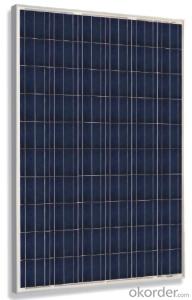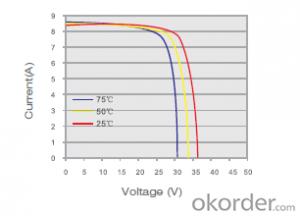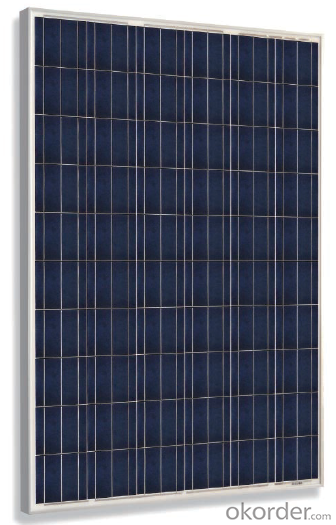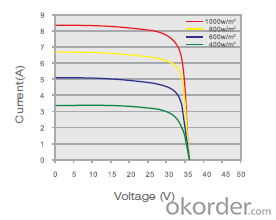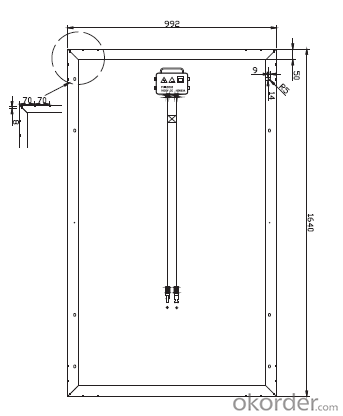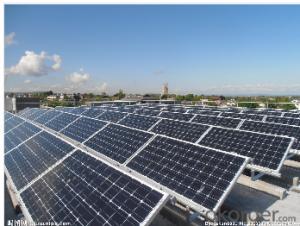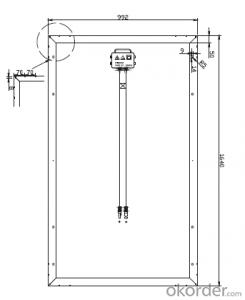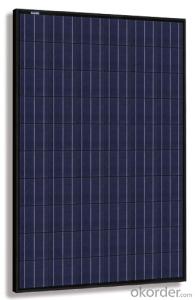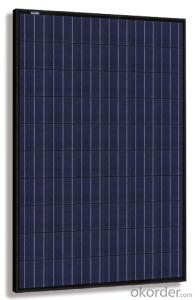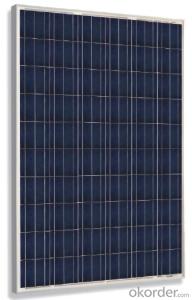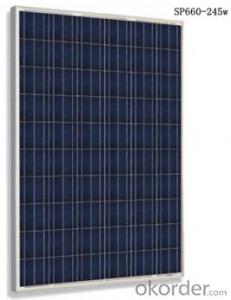Slim Polycrystalline Solar Module SP660-235W
- Loading Port:
- Shanghai
- Payment Terms:
- TT OR LC
- Min Order Qty:
- 25 set
- Supply Capability:
- 8000 set/month
OKorder Service Pledge
OKorder Financial Service
You Might Also Like
Product Description:
1.Structure of Polycrystalline Solar Module SP660-235w Series Description:
Polycrystalline Solar Module SP660-235w : High efficiency crystalline solar cell. Even if under the weak light, the solar module can produce maximum power output.
II Tempered glass (toughened glass): Anti-reflecting coating and high transmission rate glass increase the power output and mechanical strength of solar module.
III EVA and TPT: Using high quality EVA and TPT to prevent destroying and water.
IV AI frame: Without screw, rner connection. 6 holes on the frame can be installed easily.
V Junction box: Multi function junction box with water proof.
VI Long lifetime: ≥25 years; Less power decrease.
VII Good performance of preventing from atrocious weather such as wind and hails.
VIII Resisting moisture and etching effectively, not effected by geology.
IX The certificate issued by international authority: TUV, IEC, CE.ISO9001.MCS
2. Standard Test Conditions of Polycrystalline Silicon Solar Panel:
The opto-electrical specifications shown below are stabilized values being measured at Standard Test Conditions, Irradiance: 1000W/m2, Spectrum: AM1.5 at 25°C, The info below is subject to manufacturing tolerances. Where appropriate minutes of measurement are available and are used for the dimensioning of the installation.
Advantages of Polycrystalline Silicon Solar Panel
• 25 year transferrable power output warranty: 10 years / 90%, 25 years / 80%*
• 12 year material and workmanship warranty
• Timeliness of delivery
• Quality Products certified (TUV, IEC, CE.ISO9001.MCS)
3. Characteristics of PolycrystallineSilicon Solar Panel:
• Guaranteed tolerance +3%
• High manufacture standards
• Reliable power output
• High module efficiency
• Module efficiency up to 15.5%
• Cells efficiency up to 17.6%
• Strong compressive strength
• Certified to withstand high wind of 2400Pa
4. Solar Panel Images
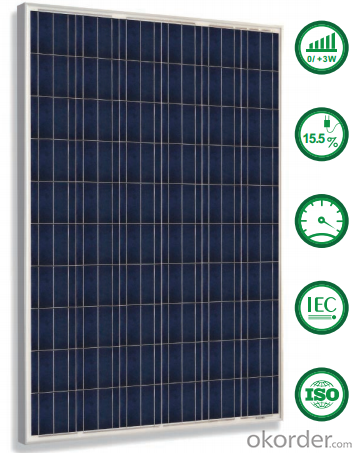
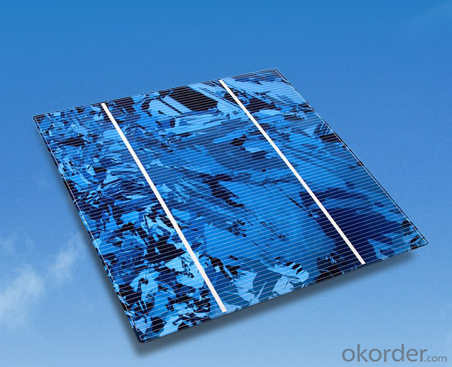


5. Polycrystalline Silicon Solar Panel Specification
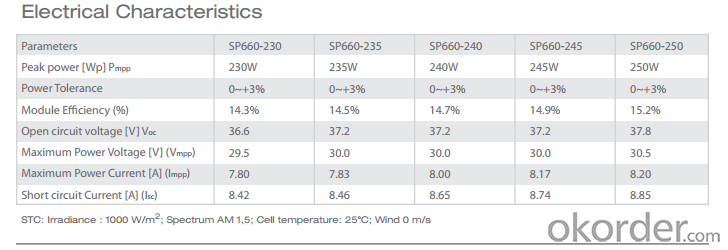
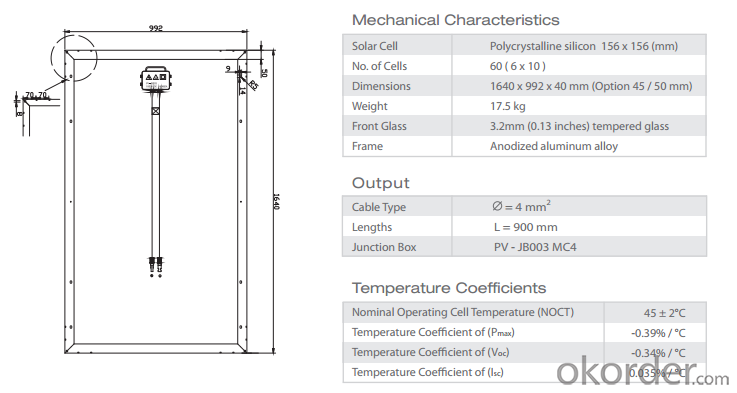


6.FAQ
We have organized several common questions for our clients,may help you sincerely:
①How about your company?
We are a private-owned high-tech company who specializes in developing, manufacturing and marketing of silicon ingots, solar wafer, solar cells, solar modules, PV systems and solar applications products.
At present, We has one research & development team, whose members are well-known experts in photovoltaic area. We also have advanced production and test equipment.
②How to guarantee the quality of the products?
Our products have been certified by CE, CEC,MCS, IEC61215, IEC61730 and ISO9001.
• 25 year transferrable power output warranty: 10 years / 90%, 25 years / 80%*
• 12 year material and workmanship warranty
• Timeliness of delivery
• Quality Products certified (TUV, IEC, CE.ISO9001.MCS)
③How long can we receive the product after purchase?
In the purchase of product within three working days, We will arrange the factory delivery as soon as possible. The pecific time of receiving is related to the state and position of customers.Commonly 7 to 10 working days can be served.
- Q: Please tell me what they are made of and how the materials help the solar cell produce electricity. Im doing a science projects so i need help on knowing all this info. Its a debate, so i need correct information please.I will please need more information about the bad things about solar energy and solar panels. Please say what solar panels do to create pollution or do anything that is not friendly to the environment. If you want just give me a website. Thank you
- A okorder /, or resistance—vary when light is incident upon it) which, when exposed to light, can generate and support an electric current without being attached to any external voltage source, but do require an external load for power consumption.
- Q: I need a new roof soon and I was wondering what the difference in cost would be from a standard shingle roof to a roof including solar panels. Does anyone know the cost difference?
- The solar panels are very expensive to provide much power. If u go that way do not skimp on the support as a high wind will blow them away. In Ecuador I put in a remote site for communications. It was working good when a Strong wind blew $0.000 worth of solar panels all over the jungle.
- Q: Can solar panels be used to power a farm?
- Yes, solar panels can be used to power a farm. By harnessing the power of the sun, solar panels can generate electricity that can be used to run various farm operations such as irrigation systems, grain dryers, electric fencing, and even power agricultural machinery. This renewable energy source not only reduces reliance on fossil fuels but also helps farmers save on energy costs while promoting sustainability.
- Q: Are solar panels worth the investment?
- Yes, solar panels are worth the investment. They have numerous long-term benefits such as significant energy savings, reduction in electricity bills, and a positive environmental impact by reducing carbon emissions. Additionally, many governments offer incentives and tax credits for installing solar panels, further enhancing the return on investment.
- Q: im interested in starting a solar panel manufacturing company. ive researched on how to make them and it doesnt look too hard, and is definitely something i can figure out. i would be starting from nothing so my question is what are the chances of me actually selling a lot of panels and the business actually succeding?thanks
- No okorder 3) Figure out how much labor and material cost would go into each panel. Would you locate in the US? It's hard to beat the big players in China, in this commodity market. It would be like having a small company to make laptops, and trying to beat HP, Dell,and Lenovo.
- Q: I made three 36 solar cell (3x6 .5V 3.5A) panel and had it hooked a up to an old car inverter. I was on line looking for a cheap grid tied inverter. I came across the Enphase micro inverter and was wondering if i could use one of those. Will it work?
- It won't work for several reasons. ) Enphase needs 24V modules, you made 8V ones. The voltage is too low to turn it on. 2) Only UL listed (or similar lab) panels are allowed to be connected to your house electrical system. Even if you did get them to work with the Enphase, you won't be able to get the system inspected, there is no way it would be allowed to be turned on by the electrical inspector nor the electric company. 3) If you got by obstacles and 2, and you had an electrical fire in your house, it is highly likely your insurance company would not pay you for it, as you used non-UL panels. DIY panels are fine for little back yard projects, but when it comes to your home, buy real ones. The price has dropped so much in the last 2 years, it's not worth it to mess around.
- Q: I have a question about solar panels. What are the benefits of this system if I installed in my home. for example i know it produces electricity but does it do anything else? How many panel would you guys think I would need for 2000 sq ft. do you know if it produces hot water? Thanks for your help
- Grid-tied solar systems in the U.S. run at least $8/watt installed. To completely run a 2,000 sq ft home, you'd need about 50 amps service from solar -- both 20 volts and 240 volts. Not very practical. Panels are expensive, but the BOS (balance of system) is as well. You need mounts to bolt the panels to the roof (same thing if ground mounted). Cable, wire, and connectors will run several hundred dollars. A couple of grid-tie inverters in the range of 4,000 watts each will cost you several $6,000 to $8,000, plus sub panels, combiner boxes, breakers, disconnects, charge controls, and batteries, among other things. You'd likely need 5 to 24 panels, depending on too many factors to mention here. You'd need at least 8 batteries, likely 2 volt ones, probably more if you want to run the entire home from solar. Solar (or wind) systems have to be installed in the U.S. by state licensed installers, and there are not many of those yet. And if you grid-tie the system, you'll need to put an interconnection agreement in place with your local utility, plus the utility will have requirements on the net-metering and installation of a switch they can use to turn your solar system off from the grid. And this would not produce hot water in the way you are thinking. If you have an electric hot water heater now, the solar system could help run that, just like the rest of your home. Hot water from solar and electricity from solar are two completely different technologies.
- Q: How do solar panels affect the overall sustainability of a building?
- Solar panels positively affect the overall sustainability of a building by reducing reliance on non-renewable energy sources and decreasing carbon emissions. They generate clean and renewable energy from the sun, reducing the building's environmental footprint and contributing to a greener future. Additionally, solar panels can lower energy costs, increase energy efficiency, and provide energy independence, making the building more resilient and sustainable in the long run.
- Q: For part of a school project how would I charge a car battery with a solar panel? The panel is 48V and 6A. This needs to be low budget so I can't buy an expensive controller, Is that the only way or are there other ways of doing it?
- I okorder /... typical use page 8. These chips and the supporting capacitors should only cost a few ? (or $) but you will need to make a circuit board.
- Q: how to build a solar panel
- Search Yahoo Answers or the internet first, this question is common. It is possible to build a solar thermal panel, to heat either water or air. You can just search YouTube to see how people did it. Try searching solar water heater. If you build a photovoltaic (solar electric) panel on your own, it will only be good for demonstration purposes. The homemade type I've seen produces only microamps of current - not even enough to run an iPod. Be wary of sites advertise you can make your own panel for less than $200 (or some figure), and try to sell you the plans. This is the same information that is posed on other sites for free.
Send your message to us
Slim Polycrystalline Solar Module SP660-235W
- Loading Port:
- Shanghai
- Payment Terms:
- TT OR LC
- Min Order Qty:
- 25 set
- Supply Capability:
- 8000 set/month
OKorder Service Pledge
OKorder Financial Service
Similar products
Hot products
Hot Searches
Related keywords
